Tying a karate belt correctly is essential for any martial artist. Whether you are a beginner or an experienced practitioner, mastering the proper method of tying a karate belt is crucial to maintaining a secure fit and reflecting your commitment to your training.
In this guide, we will provide you with step-by-step instructions on how to tie your karate belt correctly, ensuring that it remains securely fastened throughout your practice sessions and competitions.
Key Takeaways:
- Follow these step-by-step instructions to tie your karate belt correctly.
- Properly folding and positioning the belt at your navel is the first step.
- Wrap the ends around your waist, overlapping them on your stomach.
- Tuck the top end underneath the layers of the belt to create a secure knot.
- Pull the bottom end up through the middle of the crossed ends and tighten the knot.
Step 1: Fold the Belt in Half
To begin, fold the karate belt exactly in half. This will help you find the center of the belt, which is important for tying it correctly. Ensure that the ends of the belt are even and the material is smooth.
By folding the belt in half, you create a reference point for the rest of the tying process. This step sets the foundation for a secure and tidy knot.
Step 2: Position the Belt at the Navel
Now that you have folded the belt in half, it’s time to position it at your navel. This step is crucial for ensuring that your karate belt is tied securely and evenly.
Unfold the belt so that it becomes one long line. Begin wrapping it around your stomach, making sure that both sides of the belt are even and positioned correctly.
Take a moment to ensure that the belt is snug but not overly tight, allowing for movement and comfort during your karate practice. The proper placement of the belt at your navel is not only important for aesthetic reasons but also serves as a practical measure to keep it secure during your training.
It is essential to pay attention to detail in this step to ensure that your karate belt remains in place throughout your martial arts sessions. By following this proper positioning, you’ll be one step closer to correctly tying your karate belt.
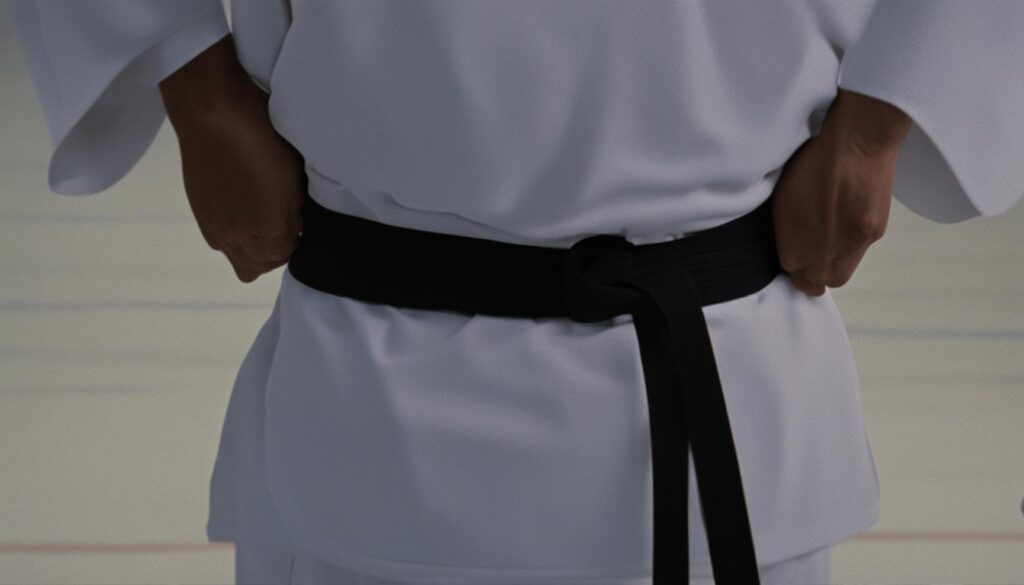
| Benefits of Positioning the Belt Correctly at the Navel: |
|---|
| Ensures a secure and even fit |
| Prevents the belt from slipping or coming undone |
| Creates a neat and tidy appearance |
| Reflects your commitment to discipline and tradition |
Step 3: Wrap the Ends Around the Waist
Now that you have folded the belt and positioned it correctly, it’s time to wrap the ends around your waist. Start by bringing both ends of the belt to the back and cross them over each other just below your waistline.
Next, bring the ends back around to the front, making sure they are still even and aligned in front of you. This step ensures that the belt stays secure throughout your martial arts practice.
Remember, the proper positioning and wrapping of the belt are crucial for a comfortable fit and to maintain professionalism during your training sessions.
Step 4: Overlap the Ends on the Stomach
Now that you have wrapped the karate belt around your waist, it’s time to create a secure knot. Start by taking one end of the belt and folding it over the center, laying it on the belt over your stomach. Ensure that the fold is neat and the end is flat against the belt.
Next, repeat this step with the other end of the belt. Cross it over the fold you just made, directly over your belly button. The two ends of the belt should overlap each other, creating a secure and unified look.
Remember, the way you overlap the ends can create different variations of the karate belt knot. Feel free to experiment and find a style that suits you.
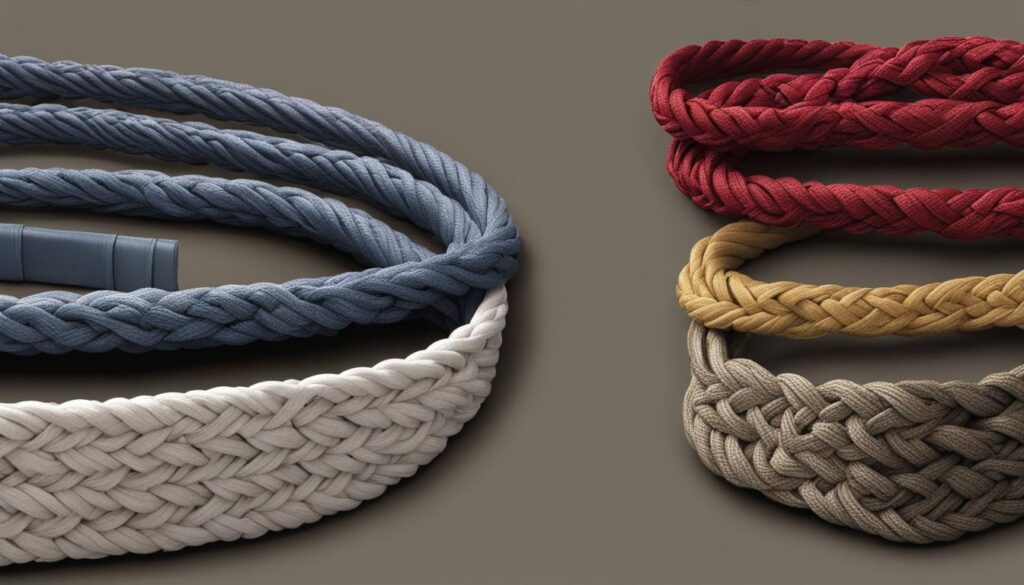
Creating Different Karate Belt Knot Variations
| Knot Variation | Appearance | Instructions |
|---|---|---|
| The Square Knot | A neat and symmetrical knot. | After overlapping the ends on the stomach, cross one end over the other and pass it through the loop created. Pull both ends to tighten. |
| The Cross Knot | A visually striking knot that resembles a cross. | After overlapping the ends on the stomach, cross one end diagonally over the other. Pass it through the loop created and pull both ends to tighten. |
| The Braid Knot | A unique knot that resembles a braided pattern. | After overlapping the ends on the stomach, cross one end diagonally under the other. Bring it up through the loop created and pull both ends to tighten. |
These are just a few examples of the many knot variations you can create. Have fun exploring different styles to give your karate belt a unique and personalized touch!
Step 5: Tuck the Top End Underneath
Now that the belt is crossed over your stomach, it’s time to secure it in place. Take the top end of the belt, which is on the very top of the crossed ends, and carefully tuck it underneath all the layers of the belt. Ensure that you pull it up towards you to create a small knot.
Make sure the knot is tight enough to keep the belt in place during your karate practice, but still allows for movement and breathing.
Note: The image above demonstrates the correct technique for tying a karate belt securely.
Step 6: Fold the Bottom End and Tie a Knot
Now that the top end of the belt is secure, it’s time to finish tying your karate belt with a final knot. Follow these simple steps to complete the process:
- Cross the bottom end of the belt underneath the top end, creating a cross.
- Take the bottom end and pull it up through the middle of the cross.
- Tighten the knot by pulling both ends of the belt in opposite directions.
Remember, the goal is to have a secure knot that holds your belt in place while allowing for movement and flexibility. Adjust the belt if necessary to ensure that both ends are hanging evenly.
To better visualize the folding and knotting process, here’s a helpful diagram:
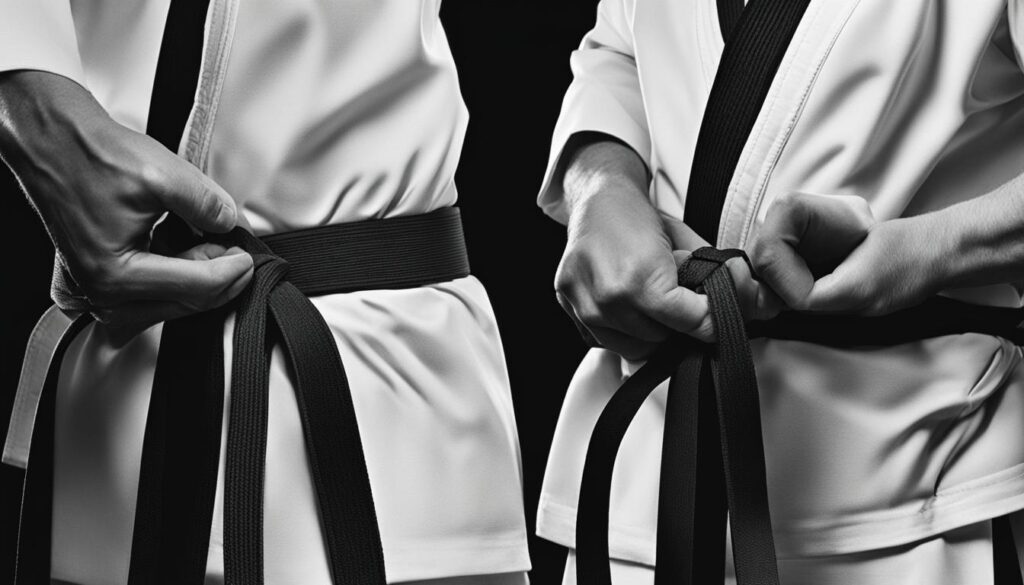
Alternative Method: Tying with One Side Longer
If you prefer a different approach to tying your karate belt, you can try the method of starting with one side longer than the other. This technique adds a unique touch to your belt tying and gives you a chance to showcase your personal style. Follow the steps below to master this alternative method:
- Begin by holding the karate belt with one end longer than the other.
- Take the longer end and wrap it around your body twice, ensuring it stays on the same side.
- Next, tuck the shorter end under the wrapped portion of the belt, creating a loop.
- Continue with the remaining steps from the previous section, starting with step 3, to secure the belt properly.
By experimenting with different methods, you can find the one that suits you best and adds a unique flair to your karate belt tying. Remember to practice regularly to improve your technique and create a neat and tidy appearance.
Continue reading to discover more tips and techniques for tying your karate belt correctly and maintaining a professional look throughout your martial arts journey.
The Importance of Correctly Tying Your Karate Belt
Tying your karate belt correctly is an essential skill that every martial artist should master. Not only does it ensure a secure fit during training and competitions, but it also holds symbolic significance in the world of martial arts. By tying your karate belt properly, you demonstrate your dedication, respect, and attention to detail.
When you tie your karate belt with precision, it reflects your mindset and commitment to your training. It shows that you take your martial arts practice seriously and are willing to put in the effort to learn and improve. A well-tied belt is a sign of discipline and focus, both of which are fundamental values in martial arts.
Tying your karate belt correctly is a form of respect for the martial arts and its traditions. It pays homage to the lineage of countless martial artists who have come before you and serves as a reminder of the principles and ethics that martial arts embody. By tying your belt properly, you honor the history and heritage of the art, fostering a deeper connection to its roots.
Attention to detail is paramount in martial arts, and correctly tying your karate belt is no exception. The process requires precision and care, as each fold, cross, and knot plays a crucial role in ensuring the belt stays secure and in place. By focusing on the finer details of belt tying, you cultivate a mindset of meticulousness and meticulousness, which can translate into other aspects of your martial arts journey.
Remember, tying your karate belt correctly is not just a technical skill but a reflection of your character and dedication. Take the time to learn and practice the proper techniques, and let your well-tied belt serve as a testament to your martial arts journey.
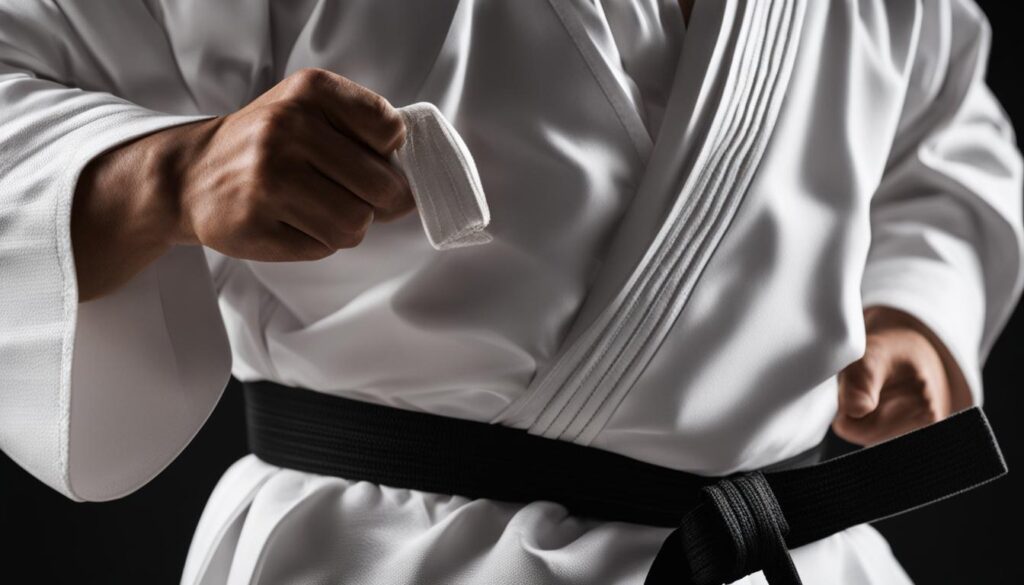
Want to learn more about tying your karate belt? Check out our helpful video tutorial below:
Tips for Tying Your Karate Belt Properly
To tie your karate belt securely, follow these tips to ensure a neat and secure fit:
- Even Ends: Always make sure that both ends of the karate belt are even in length. This will help maintain balance and prevent the belt from coming loose during training.
- Tight Knot: While it’s important to secure your belt, avoid making the knot too tight. A tight knot can restrict your movement and breathing, affecting your performance in martial arts. Find the right balance to keep your belt secure yet comfortable.
- Mirror Check: Use a mirror to check your belt after tying it. Stand in front of a mirror and ensure that the belt is straight, with both ends even and the knot centered. This will give you confidence in your appearance and ensure a professional look.
- Practice Makes Perfect: Like any skill, tying a karate belt takes practice. Set aside some time before or after your training sessions to practice tying your belt. The more you practice, the more confident and efficient you will become.
By following these tips, you can tie your karate belt securely and maintain a professional appearance during your martial arts journey.
Keeping Your Belt Neat and Tidy
Once you’ve mastered the art of tying your karate belt correctly, it’s important to maintain its appearance. Here are some tips to keep your belt clean and wrinkle-free:
- Smooth out any wrinkles: Before tying your belt, ensure that it’s smooth and free from wrinkles. Gently run your hands along the length of the belt to remove any creases.
- Store it properly: When you’re not wearing your belt, it’s essential to store it in a proper manner. Avoid throwing it in a bag or leaving it in a crumpled heap. Instead, consider hanging it on a belt rack or carefully folding it and placing it in a clean, dry place.
By taking these simple steps, you can ensure that your karate belt remains in pristine condition, reflecting your dedication and respect for the martial arts.
Tips for Maintaining Your Belt
Here are some additional tips to help you maintain the appearance of your karate belt:
- Wash it sparingly: Karate belts are traditionally not washed frequently, as they are considered a symbol of your journey and progress in the martial arts. If you do need to wash your belt, follow the manufacturer’s instructions and handle it with care.
- Avoid excessive wear and tear: While it’s important to train and practice regularly, be mindful of preventing unnecessary wear and tear on your belt. Avoid dragging it on the floor or using it for anything other than its intended purpose.
- Replace when necessary: Over time, your karate belt may show signs of aging, such as fraying or fading. When this happens, consider replacing it with a new belt to maintain a professional and polished appearance.
By following these tips, you can keep your karate belt looking its best and continue to showcase your commitment to the art of karate.
Modeling Proper Belt Tying for Children
Parents play a crucial role in teaching their children the proper techniques for tying a karate belt. By demonstrating the correct method and emphasizing the importance of maintaining a neat and tidy appearance, parents can instill values of discipline and attention to detail in their children. This not only reinforces the fundamentals of karate but also promotes a sense of responsibility and respect for the martial arts.
Children learn best by observation, so when parents tie their karate belts correctly, it serves as a visual guide for their children to follow. Take the time to explain each step of the belt tying process, ensuring that your child understands the significance of each action.
Encourage your child to practice tying their belt under your supervision. This hands-on experience allows them to develop their fine motor skills and reinforces the proper techniques they have observed. It’s important to provide gentle guidance and corrections as needed, promoting an environment of continuous learning and improvement.
By modeling the correct method of tying a karate belt, parents not only teach their children a practical skill but also instill important values and discipline. This sets the foundation for their martial arts journey and fosters a sense of pride and professionalism. Keep in mind that consistency and patience are key when teaching children any new skill.
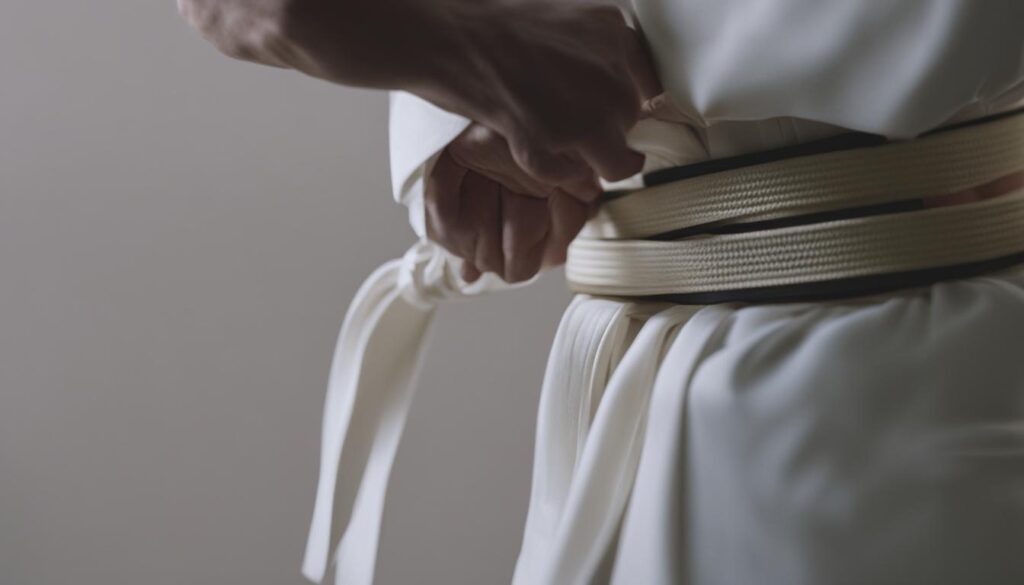
Modeling proper belt tying for children serves as a way to connect and bond through the shared experience of martial arts. It reinforces the notion that karate is not just a physical activity but also a discipline that extends to every aspect of life. By teaching your child the importance of attention to detail and maintaining a neat appearance, you are equipping them with valuable lessons that will transcend their training and benefit them in the long run.
Conclusion
Tying a karate belt correctly is a fundamental skill for any martial artist. By following the step-by-step instructions and paying attention to detail, you can ensure a secure and neat appearance, reflecting your dedication to your training.
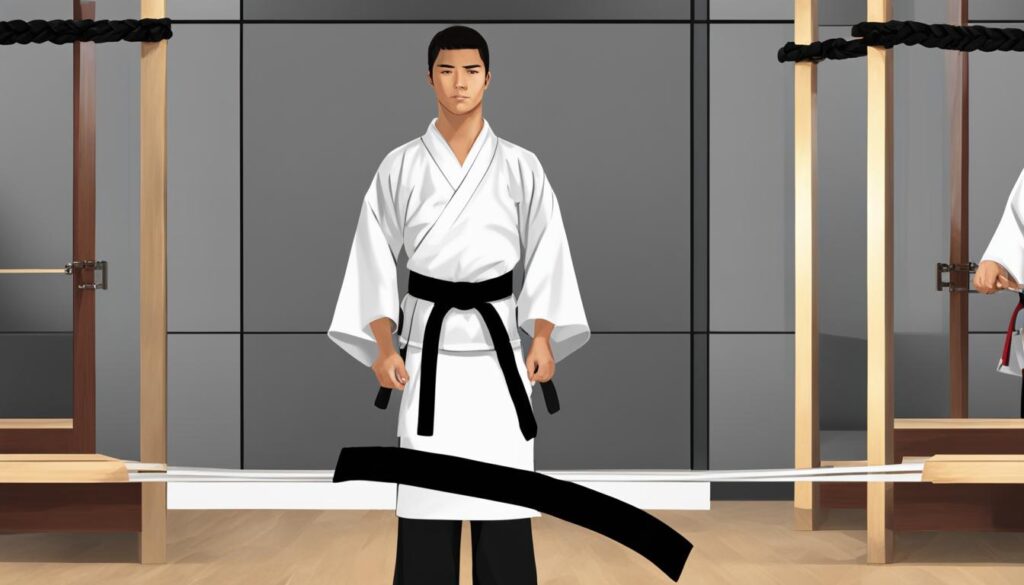
Properly tying your karate belt not only ensures a secure fit but also demonstrates your respect for the martial arts. It is a reflection of your commitment and attention to detail. By following the karate belt tying techniques discussed in this guide, you can create a neat and professional look that embodies the spirit of karate.
Remember to fold the belt in half and position it correctly at your navel. Wrap the ends around your waist, cross them over each other, and overlap them on your stomach. Securely tie the knot, making sure it is tight but allows for movement and breathing.
Whether you are a beginner or an experienced martial artist, mastering the correct way to tie your karate belt is essential. Practice regularly, check your belt in the mirror, and maintain a neat appearance to showcase your dedication to your training.
Learn More About Karate Belt Tying
If you’re interested in honing your karate belt tying skills, we recommend exploring additional resources such as videos and articles that provide valuable tips and techniques. Expand your knowledge and improve your technique with these recommended resources.
Video: Karate Belt Tying Tutorial
Master the art of tying your karate belt correctly with this informative tutorial. Follow the step-by-step instructions to ensure a secure and tidy knot.
Article: Karate Belt Tying Instructions for Beginners
For beginners who are just starting their martial arts journey, this article offers detailed instructions on how to tie a karate belt properly. Learn the fundamental techniques and gain confidence in your belt tying skills.
Video: Advanced Karate Belt Tying Techniques
Looking to take your belt tying skills to the next level? This video showcases advanced techniques such as decorative knots and unique belt arrangements. Learn new ways to showcase your dedication to the art of karate.
By exploring these resources, you’ll gain a deeper understanding of the intricacies of karate belt tying. Whether you’re a beginner or looking to refine your skills, these tutorials and articles will provide valuable insights and help elevate your belt tying technique.
Discover the Benefits of Martial Arts Training
Martial arts training offers a wide range of benefits that extend far beyond tying a karate belt. Whether you’re a beginner or an experienced practitioner, engaging in martial arts can have a profound impact on your physical fitness, mental well-being, and personal growth.
One of the most evident advantages of martial arts training is the improvement of physical fitness. Regular practice helps build strength, agility, flexibility, and endurance. By combining dynamic movements, kicks, punches, and other techniques, martial arts provide a full-body workout that engages all major muscle groups and enhances cardiovascular health.
Moreover, martial arts training goes beyond physical strength. It cultivates discipline, focus, and mental resilience. The practice of precise techniques, patterns, and forms requires concentration and mindfulness, allowing practitioners to develop a strong mind-body connection.
Self-defense skills are another valuable aspect of martial arts training. Learning various martial arts techniques equips individuals with the knowledge and confidence to protect themselves and others if necessary. Acquiring these skills can enhance personal safety, boost self-confidence, and provide a sense of empowerment.
Beyond the physical and self-defense aspects, martial arts training promotes personal development on a deeper level. Many disciplines emphasize core principles such as respect, integrity, self-discipline, and humility. These values are instilled through regular practice and interactions with instructors and fellow students, creating a positive and supportive environment for personal growth.
“Martial arts training not only builds physical strength but also cultivates discipline, mental resilience, and self-confidence.”
Furthermore, martial arts training provides an excellent avenue for stress relief and mental well-being. The focused and repetitive nature of training helps individuals break free from the pressures of daily life, allowing them to channel their energy into a positive outlet. This can lead to reduced stress levels, improved mental clarity, and enhanced overall emotional well-being.
In summary, martial arts training offers a comprehensive approach to physical fitness, mental well-being, and personal development. By engaging in regular practice, individuals can enjoy the physical benefits, develop self-defense skills, and cultivate discipline and resilience. Moreover, the values and principles instilled in martial arts training extend beyond the training space and positively impact various aspects of life.
| Benefits of Martial Arts Training |
|---|
| 1. Improved physical fitness |
| 2. Enhanced mental focus and resilience |
| 3. Self-defense skills and confidence |
| 4. Personal growth and character development |
| 5. Stress relief and emotional well-being |
Recommended Products for Karate Training
If you’re looking to enhance your karate training experience, we have a range of high-quality karate training products and essential equipment that will help you elevate your skills and reach your full potential.
Our selection includes top-of-the-line karate uniforms that provide comfort, durability, and freedom of movement. We offer a variety of sizes and styles to suit practitioners of all ages and levels. With our karate uniforms, you can train with confidence and focus on perfecting your techniques.
In addition to karate uniforms, we also offer a wide range of belts, from beginner to advanced levels. Our belts are designed to withstand rigorous training sessions while maintaining their color and quality. Whether you’re a white belt just starting your journey or a black belt aiming for mastery, we have the right belt for you.
To supplement your training, we provide a selection of essential karate equipment such as hand wraps, shin guards, and gloves. These protective gear items are designed with your safety in mind, allowing you to train with intensity while minimizing the risk of injuries.
Invest in the best karate training products and equipment to maximize your performance and make the most out of your martial arts journey. Browse our collection today and equip yourself with the tools you need to excel in karate.
FAQ
How do I tie a karate belt correctly?
Follow these step-by-step instructions to tie a karate belt correctly:
What is the first step in tying a karate belt?
The first step is to fold the belt exactly in half to find the center.
Where should I position the karate belt?
Position the center of the belt at your navel and wrap it around your stomach, ensuring both sides are even.
How do I overlap the ends of the karate belt?
Bring the ends of the belt around your waist and cross them over each other at the back before bringing them back around to the front.
What should I do with the top end of the karate belt?
Take the top end of the belt and fold it over the center, laying it on the belt over your stomach.
How do I tie a knot with the karate belt?
After folding the top end, take the bottom end of the belt and cross it underneath the top end. Pull the bottom end up through the middle of the cross and tighten the knot.
Are there alternative methods to tie a karate belt?
Yes, you can start with one side longer, wrap it around twice, and tuck the shorter side under the wrapped portion before following the remaining steps to tie the belt securely.
Why is correctly tying a karate belt important?
Tying a karate belt correctly reflects your mindset and commitment to your training, showing respect for the martial arts and attention to detail.
Any tips for tying a karate belt properly?
Always ensure the ends are even and the knot is tight but not restrictive. Use a mirror to check your belt and practice regularly to improve your technique.
How should I maintain the appearance of my karate belt?
Keep your belt clean and wrinkle-free, and smooth out any wrinkles before tying it. Store it properly when not in use.
How can I set a good example for my children when tying a karate belt?
Tie your karate belt correctly, emphasizing the importance of a neat and tidy appearance. This reinforces values of discipline and attention to detail for your children.
What are some additional resources on karate belt tying?
Check out our recommended videos and articles for more tips and techniques on tying a karate belt.
What are the benefits of martial arts training?
Martial arts training offers physical fitness, self-defense skills, and personal development.
Are there any recommended products for karate training?
Yes, we recommend checking out our selection of karate uniforms, belts, and other essential equipment for your martial arts journey.
